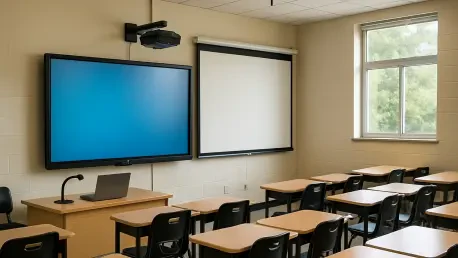In an era where technology shapes nearly every aspect of daily life, Naperville School District 203 in Illinois stands at the forefront of educational innovation with a comprehensive IT strategy that extends through the 2029-30 school year. This ambitious plan, unveiled during a recent Board of Education meeting, focuses on transforming classrooms into dynamic, tech-driven environments through substantial investments in interactive tools, student devices, and robust digital infrastructure. Spearheaded by district leaders, the initiative not only addresses current educational needs but also anticipates future demands, ensuring students and educators are equipped for a rapidly evolving world. By balancing cutting-edge advancements with fiscal responsibility, Naperville 203 is setting a benchmark for how technology can redefine learning experiences. This forward-thinking approach promises to create equitable access to modern resources across all grade levels, marking a significant step toward preparing students for success beyond the classroom.
Modernizing Classrooms with Interactive Tools
A pivotal element of Naperville 203’s technology overhaul is the transition from outdated Smartboards to advanced interactive touchboards in every classroom throughout the district. With an annual budget allocation of approximately $979,000, this upgrade seeks to revolutionize the way lessons are delivered by introducing intuitive features that enhance student engagement and foster collaboration. Pilot programs initiated in junior high and high school settings, now extending to elementary levels, have yielded overwhelmingly positive responses from both teachers and students. The touchboards’ user-friendly design allows for seamless interaction, turning traditional lessons into immersive experiences that encourage active participation. This move aligns with broader educational trends emphasizing the importance of technology that adapts to diverse learning styles, positioning the district as a leader in creating vibrant, responsive classroom environments.
Beyond the initial rollout, the focus on interactive touchboards reflects a deeper commitment to long-term educational improvement within Naperville 203. The district’s strategy involves continuous evaluation of feedback from pilot implementations to refine the integration process, ensuring that the technology meets the specific needs of different age groups and subjects. This careful, evidence-based approach minimizes disruptions while maximizing the benefits of these tools, such as improved visual aids and real-time collaboration capabilities. Additionally, by investing in durable, high-quality equipment, the district aims to reduce maintenance costs over time, demonstrating a pragmatic balance between innovation and sustainability. As classrooms evolve into hubs of digital interaction, Naperville 203 is paving the way for a more connected and engaging learning journey, setting an example for other districts to follow in prioritizing student-centered technology.
Equipping Students with Essential Digital Skills
Another critical facet of Naperville 203’s IT plan is the strategic management of one-to-one student devices, with replacement cycles extended to four years to ensure fiscal sustainability. Starting from 2026-27, annual budgets ranging from $1.4 million to $2.5 million will support this initiative, allowing for a staggered approach that prevents overwhelming financial strain in any single year. This methodical planning ensures that students consistently have access to up-to-date hardware capable of supporting modern educational software and applications. By spacing out replacements, the district not only maintains a high standard of technology but also creates a predictable budgeting framework, reflecting a thoughtful strategy that prioritizes both access and affordability in equipping students with essential tools for learning.
In parallel, Naperville 203 is addressing a pressing skill gap by piloting Windows software on high school devices, responding to feedback that many graduates lack basic proficiency in essential functions like file management upon entering college or the workforce. This initiative underscores the district’s responsiveness to real-world demands, ensuring that students are not just familiar with technology but are adept in using systems widely prevalent in professional and academic settings. The pilot program serves as a testing ground to fine-tune software integration, with the potential for broader implementation based on its success. By focusing on practical digital literacy, the district is preparing students for future challenges, bridging the divide between classroom learning and the technological expectations of higher education and careers, thus enhancing their readiness for life beyond school.
Building a Robust Digital Backbone
A cornerstone of Naperville 203’s vision for the future is a significant $2.6 million upgrade to wireless internet infrastructure, scheduled for the 2026-27 fiscal year, aimed at ensuring all school buildings can support the growing reliance on digital tools. This major project is designed to provide seamless connectivity across classrooms and common areas, addressing the increasing demand for online resources and cloud-based learning platforms. District leaders are actively pursuing a 40% federal rebate to offset costs, though they remain mindful of uncertainties surrounding such funding. This cautious optimism highlights a realistic approach to planning, ensuring that the infrastructure overhaul aligns with the latest advancements in technology to offer reliable, high-speed access that underpins modern educational practices.
The emphasis on wireless upgrades goes beyond mere connectivity, reflecting a broader understanding of how integral a strong digital foundation is to fostering an effective learning environment in Naperville 203. This initiative will enable the smooth operation of interactive tools and student devices, eliminating bottlenecks that could hinder educational delivery. By prioritizing cutting-edge technology in this upgrade, the district is future-proofing its schools against the rapid pace of digital evolution, ensuring that students and educators can access resources without interruption. The strategic timing of the project also allows for leveraging emerging innovations, positioning the district to adapt to unforeseen technological shifts while maintaining a focus on creating equitable access to digital learning opportunities across all facilities.
Balancing Innovation with Strategic Financial Planning
Naperville 203’s IT capital budget, typically ranging between $5 million and $6 million annually, showcases a flexible yet disciplined approach to funding technological advancements, with a notable spike to $7.29 million in 2026-27 to accommodate the wireless infrastructure project. This adaptability in financial planning allows the district to prioritize critical initiatives without compromising other operational needs, ensuring that investments are timed to maximize impact. By maintaining a forward-looking perspective, the budget framework leaves room to incorporate emerging technologies as they become available, demonstrating a commitment to staying at the forefront of educational innovation while carefully managing resources to avoid fiscal overreach.
Reflecting on the broader implications, the district’s strategic budgeting over past years reveals a keen ability to balance ambition with pragmatism, as seen in the staggered investments for device replacements and classroom upgrades. This thoughtful allocation of funds ensures that each technological advancement, from touchboards to connectivity, is implemented with a clear purpose and measurable outcomes in mind. Looking ahead, the focus should remain on monitoring the effectiveness of these initiatives, adjusting financial plans as needed to address evolving educational priorities. Exploring additional partnerships or funding opportunities could further support these efforts, ensuring that Naperville 203 continues to lead in creating tech-enhanced learning environments that empower students for future success.









